#sciencedirect
Explore tagged Tumblr posts
Text
كيف يتخلَّصُ الدماغ من المُخلَّفات الناجمة عن نشاطه؟
ما هذه المجموعة من المختارات تسألني؟ إنّها عددٌ من أعداد نشرة “صيد الشابكة” اِعرف أكثر عن النشرة هنا: ما هي نشرة “صيد الشابكة” ما مصادرها، وما غرضها؛ وما معنى الشابكة أصلًا؟! 🎣🌐 🎣🌐 صيد الشابكة العدد #96 السلام عليكم؛ وبسم الله ومرحبًا بكم. 🎣🌐 صيد الشابكة العدد #96🧠🥫 طعام الفكر🌟 كارُوسيل اختبار الشخصيّة حُلم “اختبار ممتاز للشخصيات” 📁 من الأرشيف✨ مُبشّر🔌🧠 جدير بالاطلاعمن العدد الجديد من مجلة…
#: The Empowered Author#Closer To Truth#Jon Hamilton#Mahnoor Chaudhry#Maris Kreizman#NPR#Robert Lawrence Kuhn#ScienceDirect#Secretorum#Shots HEALTH NEWS FROM NPR#Startup Stash#the Creative Archive#قناة Closer To Truth#كارُوسيل#منال الحربي#مؤسسة أقواس الإعلامية#مدونة منال الحربي#نشرة : The Empowered Author#نشرة Secretorum#نشرة Startup Stash#نشرة محمد عمار البريدية#نشرة [SC 2.4.4]#نشرة المستجدات القانونية#نشرة خياليون#[SC 2.4.4]#الجامعة الإسلامية العالمية ماليزيا#الدكتور خالد عزب#احمد فارس السعود#اختبار الشخصية حلم#ســالــي الــزيــد
0 notes
Text
Atherosclerosis over time - images
Someone, likely the individual who posted the video, has deleted the following links I provided in the youtube comment section. The URLs were provided due to the host/narrator/speaker CONTINUALLY has her head ‘blocking’ some of the content that many would like to see. The video title: Lower & Reverse High Cholesterol: Top 10 Best Ways. I was saving the interested parties time by finding those…
View On WordPress
0 notes
Text
I found an interesting article on ScienceDirect but as is typical, only a preview was available unless you'd like to buy the full article. However, there was a login option on the page and I, just for fun, decided to give it a try. And guess what? It worked! I found my university on the list of institutions and was able to log in via a confirmation link send to my email. I don't know how I didn't realize before that of course university accounts can be used to access research papers and stuff for free but this is pretty damn convenient
#university#student life#research#research paper#science#sciencedirect#biology#evolution#development#puberty
0 notes
Text
I just had to share this video because holy shit, it hits the nail right on the head! So well spoken. This stuff needs to be circulated more, esp with the growing number of people thinking they have this because of misinformation, or just outright faking it.
#it's painful because i knew someone who personally faked this stuff (or has convinced herself she has it i can't even tell)#she had spent all her time on tiktok and i know for 100% sure that's where she got the idea. it's TRAGIC how fast things went downhill#i'm legit horrified at how many people (esp young kids of 13-14) think they have this too. or are just pretending#i've been neck deep in hardcore research (and i'm talking pubmed sciencedirect etc only) for months#and those kids definitely don't have did.. if they have trauma and are dissociating it's going to be something else like dpdr etc#the number of stupid 'you have did' answers i see for totally basic questions like 'i got dizzy what's wrong w me' is insane too#it's like googling 'muscle twitch' and then thinking you have some rare 1/billion familial cancer thing despite other obvious explanations#but worse.. in these cases the information is being fed to them. they don't have an opportunity to explore other possibilities#and the worst part is they don't even know to CHECK THE VALIDITY OF WHAT THESE PEOPLE ARE SAYING. they don't have info literacy#like i'll say this once: did is so rare that it's STILL contentious about whether it even exists#and it only happens in the most unimaginably traumatic experiences. think of the worst possible things you could do to a child#where even just thinking about it makes you uncomfortable. THAT'S the kind of trauma that leads to did. the truly evil stuff.#i'm not even gonna start on the BITE model shenanigans that are happening in the 'did' communities either#or how the people who used to be in them (and got out) always equate them to self-harming cults that celebrated not finding real answers#they got told they were 'perfect the way they were' despite having OBVIOUS psychological issues they needed help for#(it just wasn't did)#they were assured their 'did was valid no matter what'. toxic positivity ig? it just delayed their real diagnosis and ability to get help#but now you have gluts of people like in the video 'talking to themselves' and people on tumblr posting one-liners of 'alters' talking#one after the other within seconds. and i want to fcking cry because it's the same exact shit my friend did before she cut ties#the did/tourettes/ftlb stuff has literally been called a 'mass sociogenic illness' in multiple academic studies#but like qanon believers they seem to immediately discredit anyone who mentions this with 'you're just ableist' so anything you say is poo#aka you're part of the problem you're an 'ableist' so your legit info even though legit isn't valid/acceptable/real/whatever. i'm tired fam#did#dissociative identity disorder#osdd#ddnos#munchausen syndrome#mass psychogenic illness#ableism
26 notes
·
View notes
Text

Good Omens Ao3 wrapped is here! It's a bit of a long post but it goes quick:)
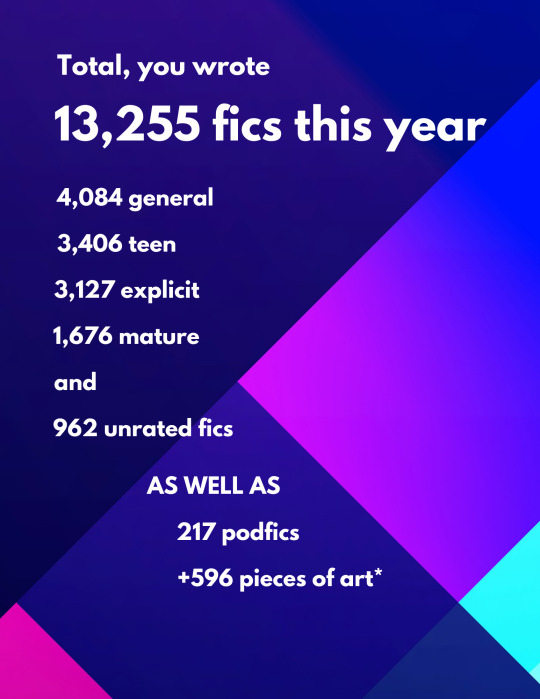
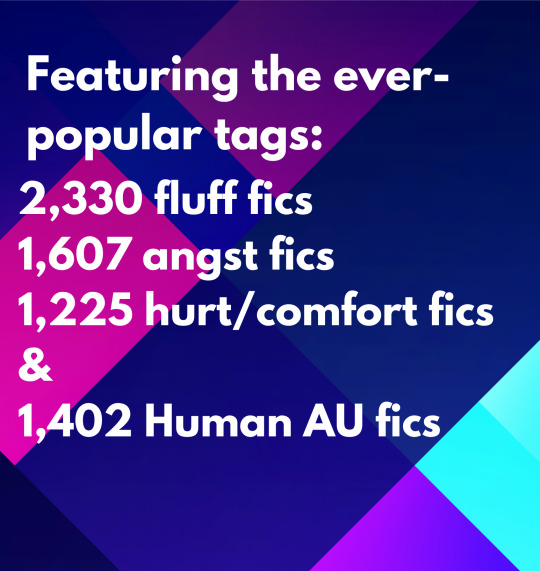

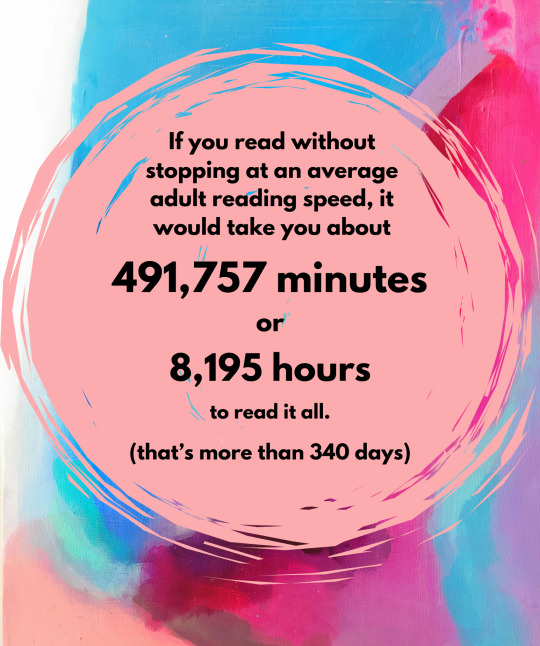

Drumroll please!!!
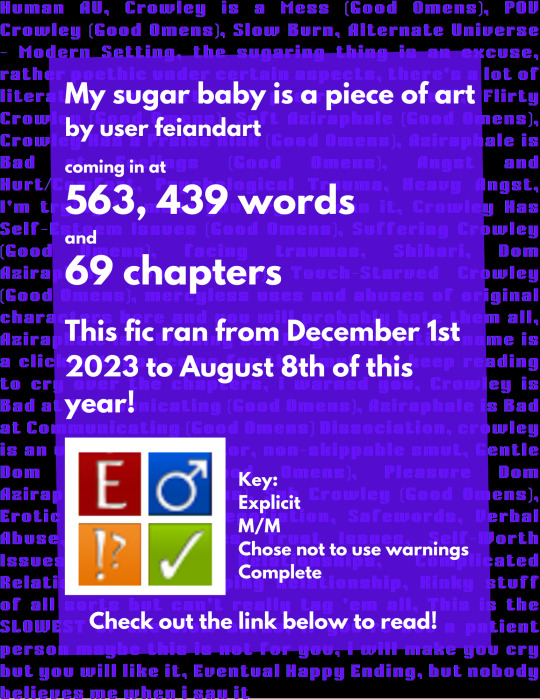
Shoutout to @feiandart for all her work on this piece!
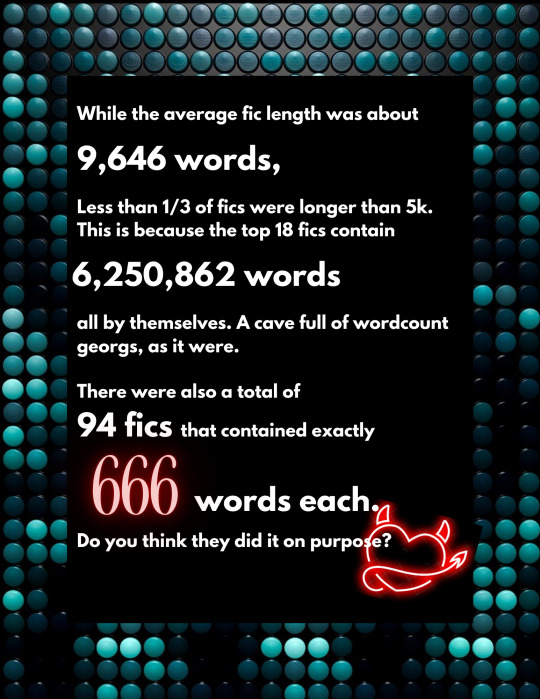
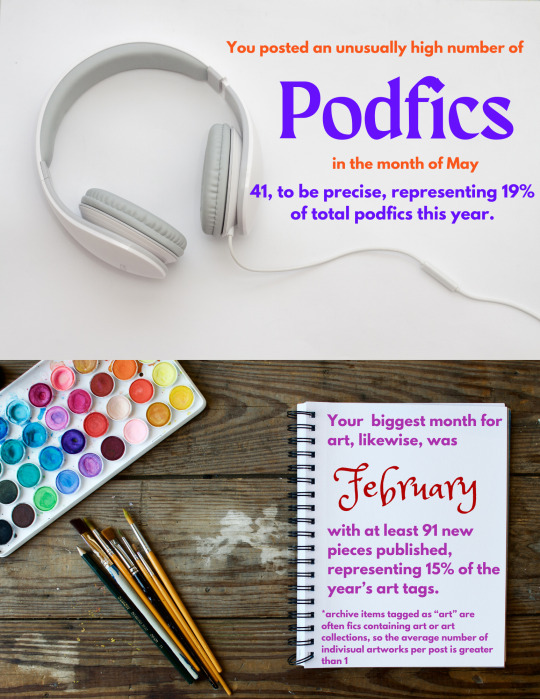

But of course, there's more! It's been a long year for the fandom, and we all processed a lot of feelings about things. Here's how we coped:
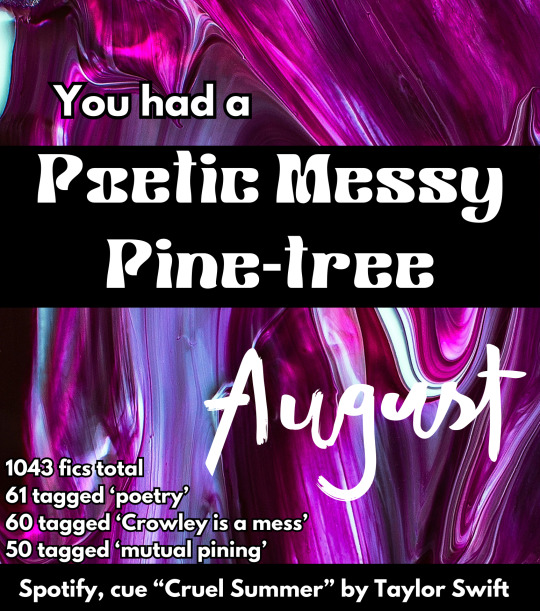


Reminder that as a reader, your comments often mean the world to writers! Fandom is a community first and foremost<3


You can click here for a more in depth explanation of the math and the raw data! This assessment is pulled by hand from the Good Omens (TV) fandom category on Archive of Our Own.
Image credits: Unsplash free images for the art and Canva stock images. Image credits in order where available:
Photo by Cassi Josh on Unsplash
Photo by Codioful (Formerly Gradienta) on Unsplash
Photo by Jason Leung on Unsplash
Photo by Geordanna Cordero on Unsplash
Photo by Tim Arterbury on Unsplash
Photo by Ahmad Dirini on Unsplash
Photo by Maria Orlova on Unsplash
Photo by Pawel Czerwinski on Unsplash
Photo by MontyLov on Unsplash
Average adult reading rate as cited is 240 wpm found on ScienceDirect.
Please reblog rather than repost, but you're welcome to share to other platforms as long as you credit me!
#fandom meta#year in review#fandom wrapped#good omens#good omens fandom#good omens fanfiction#archive of our own#ao3#ao3 stats#long post#aziracrow#ineffable husbands#fandom#gomens#nerd shit#2024 in review
668 notes
·
View notes
Text
my university: 'write this in double-spaced times new roman'
me: T_T but i like cambria
me:
me: wait this is the same exact setup in every science study ever what the hell
0 notes
Text
"The world's coral reefs are close to 25 percent larger than we thought. By using satellite images, machine learning and on-ground knowledge from a global network of people living and working on coral reefs, we found an extra 64,000 square kilometers (24,700 square miles) of coral reefs – an area the size of Ireland.
That brings the total size of the planet's shallow reefs (meaning 0-20 meters deep) to 348,000 square kilometers – the size of Germany. This figure represents whole coral reef ecosystems, ranging from sandy-bottomed lagoons with a little coral, to coral rubble flats, to living walls of coral.
Within this 348,000 km² of coral is 80,000 km² where there's a hard bottom – rocks rather than sand. These areas are likely to be home to significant amounts of coral – the places snorkelers and scuba divers most like to visit.
You might wonder why we're finding this out now. Didn't we already know where the world's reefs are?
Previously, we've had to pull data from many different sources, which made it harder to pin down the extent of coral reefs with certainty. But now we have high resolution satellite data covering the entire world – and are able to see reefs as deep as 30 meters down.
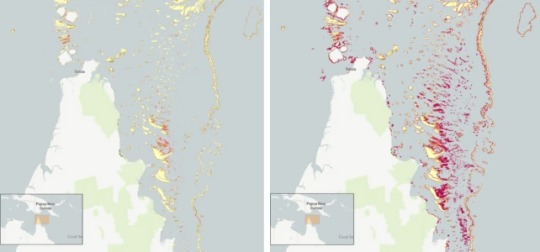
Pictured: Geomorphic mapping (left) compared to new reef extent (red shading, right image) in the northern Great Barrier Reef.
[AKA: All the stuff in red on that map is coral reef we did not realize existed!! Coral reefs cover so much more territory than we thought! And that's just one example. (From northern Queensland)]
We coupled this with direct observations and records of coral reefs from over 400 individuals and organizations in countries with coral reefs from all regions, such as the Maldives, Cuba, and Australia.
To produce the maps, we used machine learning techniques to chew through 100 trillion pixels from the Sentinel-2 and Planet Dove CubeSat satellites to make accurate predictions about where coral is – and is not. The team worked with almost 500 researchers and collaborators to make the maps.
The result: the world's first comprehensive map of coral reefs extent, and their composition, produced through the Allen Coral Atlas. [You can see the interactive maps yourself at the link!]
The maps are already proving their worth. Reef management agencies around the world are using them to plan and assess conservation work and threats to reefs."
-via ScienceDirect, February 15, 2024
#oceanography#marine biology#marine life#marine science#coral#coral reefs#environment#geography#maps#interactive maps#ai#ai positive#machine learning#conservation news#coral reef#conservation#tidalpunk#good news#hope#full disclosure this is the same topic I published a few days ago#but with a different article/much better headline that makes it clear that this is “throughout the world there are more reefs”#rather than “we just found an absolutely massive reef”#also included one of the maps this time around#bc this is a really big deal and huge sign of hope actually!!!#we were massively underestimating how many coral reefs the world has left!#and now that we know where they are we can do a much better job of protecting them
443 notes
·
View notes
Text
Why Lena doesn’t figure out Kara is Supergirl - psychoanalysis
A psychological reason for which Lena doesn’t realize Kara is Supergirl is that when faced with two similar objects the human mind likes to categorize and therefore looks for differences over similarities, especially when similarities are obvious.
Theory
Consider this thought exercise, imagine two groups of similar looking people but with completely different biology. It would probably make sense that as an observer you would try to find the smallest differences between these two groups in order to be able to tell them apart. It happens often in the world, it is part of the human developmental psychology. It helps infants be able to tell apart similar faces, and it perfects in time based on expertise through synaptic pruning.
In other words it is what makes bird enthusiasts able to figure out which birds are female or male in the same species. Or how car enthusiasts are able to tell apart similar cars. If you’re interested look up the FFA (fusiform face area) and it’s role as visual the expertise module, there are many neuro scientific studies on it.
This categorization becomes increasingly clear when the sense of me vs them in social psychology comes into play.
Lena’s Case
Now applying the same theory to Supergirl TV. Oftentimes we hear Lex’s emphasis on how kryptonians look like humans and how they are actually different from them. Us vs Them. Would it be plausible to believe that Lena growing up in the Luthor household, bearing a scientific mind would be rather inclined to look for dissimilarities rather than similarities between supergirl and other humans? Please consider her first invention in National City, the alien detector device. A little device designed to highlight these dissimilarities, coded by Lena herself. She is a scientist her expertise lies (also) in telling humans apart from aliens, biologically, not visually.
Taking it a step further. Would it be plausible that when faced with Kara and Supergirl, two people similar in so many ways (driven, ethical, stubborn, blonde, blue eyes) that she would overlook the similarities and try to find the slightest of differences in order to latch on to some small sense of security by categorizing Supergirl as “the other”.


(I could also expand on how Kara explains that Supergirl is what she can do and not who she is, further emphasizing my point on obvious emphasis on biological “otherness” over appearance) yada yada but i won’t :))
It does all boil down to cognitive dissonance and Lena’s will to overlook the similarities if we were to simplify it all. But I just thought it would do the story some justice if I could explain how neuropsychology supports that these simple disguises are more effective than one might think.
Im such a nerd, pls forgive my rant. I have a link to the study i’m referencing :) I am nothing if not thorough :)
https://www.sciencedirect.com/topics/neuroscience/fusiform-face-area#:~:text=Several%20functional%20neuroimaging%20studies%20have,configurations%20(Kanwisher%2C%202000).
#supergirl cw#supergirl#lena luthor#supercorp#katie mcgrath#kara x lena#supercorp fanfic#i ship it#glasses#kara danvers#kara zor el
77 notes
·
View notes
Note
this is gonna be a stupid question, but whats so special about the tuatara's third eye? is it not the same as a bearded dragon's third eye?
whenever you search up tuataras the third eye is always talked about - is that just because its cool for people who don't know other reptiles or is there something especially unique about them?
(tuatara photo was taken at chester zoo, uk and bearded dragon photo is of my little man wump!)


Parietal Eyes:
Ok so first off... the parietal eye (or the pineal eye) is a "third eye" on the top of the head of some animals. These eyes are basically part of or attached to the pineal gland on the brain. It is a primitive photoreceptor, that helps regulate circadian rhythm and helps track the position of the sun.
I guess what's special for some people about the Tuatara's parietal eye, is that most animals don't have one... also, I'm assuming that many people (including perhaps some science journalists) do not know that many lizards have them.
Tuataras do have the most noticeable and pronounced parietal eye.
Animals with a "third eye":
Tuatara, most lizards, frogs and salamanders, some bony fish, lampreys, and some sharks.
Read more here:
Tuatara - Wikipedia
Parietal Eye - an overview | ScienceDirect Topics
Parietal eye - Wikipedia
200 notes
·
View notes
Text
Featured Protein: Bacteriorhodopsin
this fantastic protein was suggested by @imperialinquisition, and i'm so excited i finally got around to putting together some information about it!
this protein is found in archaea – specifically Halobacterium salinarum, which are halophilic (live in extremely salty environments) obligate aerobes (need oxygen to function). it has 7 transmembrane domains and is an analog to human rhodopsin (a G-protein-coupled receptor protein in the rod cells of our eyes *note: bacteriorhodopsin is NOT a G-protein-coupled receptor, but is still in the 7TM receptor family) and forms distinct purple coloured parts of the cell membrane. this protein is also the source of a lot of interest from an engineering and biotechnology perspective.
this is one of several types of proton pumps, which transport protons across a cell membrane against an electrochemical gradient. however, the feature that makes this one so interesting is that it is powered by sunlight. when a photon of light is absorbed, all-trans-retinal (one molecule attached to each of 3 protein chains) is isomerised to 13-cis-retinal. this induces conformational changes in the rest of the protein through a 9-stage photocycle, altering the pKa values of a few conserved residues and allowing one proton to be transferred outside the cell. through this action, the inside of the cell is made 10,000-fold more basic than outside the membrane! this proton gradient is used to power ATP synthase, making most of the cell's ATP
sources:
i wasn't able to download a version of the structure with all three chains, but i found some cool images of the structure:
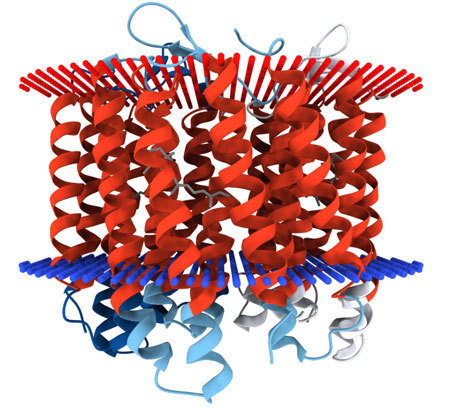

as always, if i made any mistakes, please let me know!
#science#biochemistry#biology#chemistry#stem#proteins#protein structure#science side of tumblr#protein info#protein feature
161 notes
·
View notes
Note
Here is the koi fish au I kinda typed up?
Pros to nothliting as koi:
1. CONTAINMENT - the yeerk and taxxon population becomes an inert non threat. Koi are basically powerless against humans, and it's not like they could manipulate people cuz what can Koi Esplin offer? And the greatest advantage is we can keep an eye on every single nothlit, because Koi Can't Escape, especially if we keep them in, like, Nevada or Siberia or something.
2. FAMILIAR but UPGRADED environment - a koi pond or an aquarium can be beautiful spaces. Much like a yeerk pool, yeerks natural environment, a koi pond or aquarium can house potentially hundreds of koi, and multiple can be hooked together. They could swim around, thought-speak, take visitors, even read books and use computers (depending on security level). It's a straight upgrade too, because koi experience all 5 senses and pass the mirror test, so even if you're just going from the yeerk pool to the koi pond directly, it's way better than being a yeerk OR a taxxon OR Any Wild Animal
3. COMMUNITY - yeerks, taxxons could live in community together. Humans would definitely bond with yeerks if the aquariums were visitable. Humanity is scarred by the yeerk invasion, but I believe that we could have a path forwards with our new Koi friends. Imagine this (https://www.reddit.com/r/mildlyinteresting/s/fdDEsPmZku) but giant talking goldfish are you kidding me??? I would go every day to talk to my new fish friends. Koi can also live long and fulfilling lives, unlike most wild animals.
4. Anaconda plan flaws - it wasn't clear to me why the yeerks were allowed to turn into apex predators and roam free in the first place. Seems. Likely that you'd get, oh idk, some renegade guerrilla warrior anacondas mixed in with the rest. Maybe even some who saw from precedence a whole bunch can be. If it wasn't completely clear by now, I completely disagree with Cassie on the amazon idea. You can't just loose a bunch of snakes in the amazon! You have no way of controlling the outcomes there. And nobody seems to be considering that they're all going to starve in a few months (sciencedirect com/topics/earth-and-planetary-sciences/lotka-volterra-model). Why not put them in a zoo? Or y'know. A koi pond.
*john hammond voice* Somewhere where we have a bit more control
This is amazing and I love it.
62 notes
·
View notes
Text
Reference archived on our website
Abstract
Co-infection with diverse bacteria is commonly seen in patients infected with the novel coronavirus, SARS-CoV-2. This type of co-infection significantly impacts the occurrence and development of novel coronavirus infection. Bacterial co-pathogens are typically identified in the respiratory system and blood culture, which complicates the diagnosis, treatment, and prognosis of COVID-19, and even exacerbates the severity of disease symptoms and increases mortality rates. However, the status and impact of bacterial co-infections during the COVID-19 pandemic have not been properly studied. Recently, the amount of literature on the co-infection of SARS-CoV-2 and bacteria has gradually increased, enabling a comprehensive discussion on this type of co-infection. In this study, we focus on bacterial infections in the respiratory system and blood of patients with COVID-19 because these infection types significantly affect the severity and mortality of COVID-19. Furthermore, the progression of COVID-19 has markedly elevated the antimicrobial resistance among specific bacteria, such as Klebsiella pneumoniae, in clinical settings including intensive care units (ICUs). Grasping these resistance patterns is pivotal for the optimal utilization and stewardship of antibiotics, including fluoroquinolones. Our study offers insights into these aspects and serves as a fundamental basis for devising effective therapeutic strategies. We primarily sourced our articles from PubMed, ScienceDirect, Scopus, and Google Scholar. We queried these databases using specific search terms related to COVID-19 and its co-infections with bacteria or fungi, and selectively chose relevant articles for inclusion in our review.
#mask up#covid#pandemic#covid 19#wear a mask#public health#coronavirus#sars cov 2#still coviding#wear a respirator
29 notes
·
View notes
Note
I know that there’s a phenomenon where as fields/careers shift from being male-dominated to female-dominated, they start to pay less, but has any research been done to determine specifically why this is? I know that in general women’s work is valued less, but I’ve also heard that it could be because female workers require more flexible hours due to familial responsibilities. I’ve also seen misogynists say that it’s simply because women are less skilled at these jobs, so I was hoping there’s research to address/debunk these claims as well.
I talk about this a bit in this post.
For the mechanisms, there is support for both devaluation of women's work and sexist structuring of the job market as a whole.
First, this New York Times article [1] discusses the devaluation hypothesis – that society devalues and therefore underpays work done primarily by women – and this hypothesis is also supported by research [2-4].
However, some work [2, 5] also suggests that employers penalize employees for requesting flexible work arrangements (i.e., work locations, flexible hours, etc.). I want to emphasize, however, that the fact that the workforce is structured in such a way (i.e., penalizes flexibility, does not account for the needs of "encumbered" workers like mothers or other caregivers) is based on sexism [6, 7]. Such penalties exist because we devalue women's unpaid care work, making it another expression of sexism.
Notably, changes in labor supply (i.e., there simply being more workers available) and skill differences are not supported by research [2, 7-9].
I hope this helps!
References under the cut:
Miller, Claire Cain. “As Women Take Over a Male-Dominated Field, the Pay Drops.” The New York Times, 18 Mar. 2016. NYTimes.com, https://www.nytimes.com/2016/03/20/upshot/as-women-take-over-a-male-dominated-field-the-pay-drops.html.
Harris, Jorgen. “Do Wages Fall When Women Enter an Occupation?” Labour Economics, vol. 74, Jan. 2022, p. 102102. ScienceDirect, https://doi.org/10.1016/j.labeco.2021.102102.
Levanon, A., England, P., & Allison, P. (2009). Occupational feminization and pay: Assessing causal dynamics using 1950–2000 US census data. Social forces, 88(2), 865-891.
Light, A. E., Benson-Greenwald, T. M., & Diekman, A. B. (2022). Gender representation cues labels of hard and soft sciences. Journal of Experimental Social Psychology, 98, 104234.
Deschacht, N., Vujić, S., & Frison, O. (2024). The Greedy Jobs Phenomenon as a Driving Force Behind the Gender Pay Gap: A Systematic Review. De Economist, 1-28.
Perez, C. C. (2019). Invisible women: Data bias in a world designed for men. Abrams.
Schieder, J., & Gould, E. (2016, July 20). “Women’s work” and the gender pay gap: How discrimination, societal norms, and other forces affect women’s occupational choices—and their pay. Economic Policy Institute. https://www.epi.org/publication/womens-work-and-the-gender-pay-gap-how-discrimination-societal-norms-and-other-forces-affect-womens-occupational-choices-and-their-pay/
Block, P. (2023). Understanding the self-organization of occupational sex segregation with mobility networks. Social Networks, 73, 42-50
Gunewardena,Dileni N.; King,Elizabeth M.; Valerio,Alexandria. More Than Schooling : Understanding Gender Differences in the Labor Market When Measures of Skill Are Available (English). Policy Research working paper,no. WPS 8588 Washington, D.C. : World Bank Group. http://documents.worldbank.org/curated/en/356091537360897955/More-Than-Schooling-Understanding-Gender-Differences-in-the-Labor-Market-When-Measures-of-Skill-Are-Available
15 notes
·
View notes
Photo

No street is an Island: Street network morphologies and traffic safety Publication date: Available online 22 July 2023Source: Transport PolicyAuthor(s): Zihao An, Bo Xie, Qiyang Liu https://www.sciencedirect.com/science/article/pii/S0967070X23002032?dgcid=rss_sd_all
0 notes
Text
by Suzanne Burdick, Ph.D.
The basis for the wireless industry’s claim that radiation is safe for humans is scientifically erroneous, according to the author of a new peer-reviewed scientific report.
Paul Héroux, Ph.D., authored the report, which was published Jan. 30 in Heliyon, one of Elsevier’s journals on its ScienceDirect platform.
Héroux, an associate professor of medicine at McGill University in Montreal, Canada, and a medical scientist in McGill University Health Center’s surgery department, has years of experience in physics and electrical engineering.
He is also vice chair of the International Commission on the Biological Effects of Electromagnetic Fields (ICBE-EMF), a “consortium of scientists, doctors and researchers” who study wireless radiation and make recommendations for wireless radiation exposure guidelines “based on the best peer-reviewed research publications.”
7 notes
·
View notes
Text
Sea Hawk clearly has ADHD
Which isn't something I've seen people talk about much. So here's a list a list of his ADHD traits I've noticed.
Very impulsive.
Adora: We go on three. Ready? One... Sea Hawk: Forward! Adora: I said on three. Sea Hawk: I got excited.
His tendency to set ships on fire - poor impulse control. Also his love of fire could be connected to visual stimming?
ADHD seems to be common in pyromaniacs. (Sources include Pyromania: fascination with fire - The Diamond Rehab Thailand, Pyromaniac: Meaning, symptoms, and treatment, Pyromania - an overview | ScienceDirect Topics, and others. I went down a rabbit hole trying to get statistics on what percentage of pyromaniacs are diagnosed with ADHD, but found nothing.)
His thing with singing. Vocal stimming.
RSD! His fandom wiki article says he has “a strong desire to be liked due to him being quite far from home”, but rejection sensitive dysphoria also checks out.
Tends to be very loud - trouble controlling volume?
When is he like, actually still?
Randomly starts doing squats. Not just to show off or anything either; just… to move? And what normal neurotypical train of thought would lead to one just randomly doing squats there like that?
There's some other traits I totally imagine him having too, but those are fully in headcanon territory, not things we see in the show, so I'll stop here for now.
#sea hawk#she ra#adhd#neurodivergent headcanon#adhd headcanon#sea hawk spop#she-ra#spop#she ra headcanons
62 notes
·
View notes